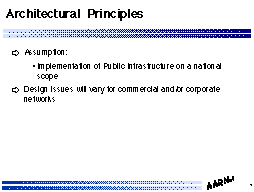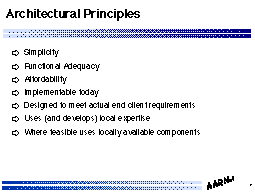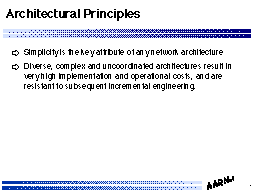 Architectural Principles
Architectural Principles
Geoff Huston, July 1994
Copyright (c) Geoff Huston, 1994
 Architectural Principles
Architectural Principles
- Assumption:
Implementation of Public Infrastructure on a national scope
Design issues will vary for commercial and/or corporate networks
There are of course a number of assumptions made within this presentation to bring the content down to finite size, but the principle assumption made here is that the subject area is that of the architecture and design of public network infrastructure which is national in scope.
Explicitly this presentation does not consider the issues in the architecture and design of corporate network service structures, or other non-public services which may be confined to a particular set of objectives.
It should also be noted that this presentation is not a comprehensive one, in so far as it is intended to cover aspects of architecture, design, operation and public policy areas, without explicitly covering related issues such as Internet infrastructure administration, Internet service structures, service offerings and access technology options, to name but a few of such additional areas of consideration. Within the scope of the ISOC Workshop for developing countries these topics were covered by other presenters within the National Network Management track, and by presenters in the other three workshop tracks.
 Architectural Principles
Architectural Principles
- Simplicity
- Functional Adequacy
- Affordability
- Implementable today
- Designed to meet actual end client requirements
- Uses (and develops) local expertise
- Where feasible uses locally available components
When considering the architectural aspects of a public national network infrastructure the major considerations are the following:
 Architectural Principles
Architectural Principles
- Simplicity is the key attribute of any network architecture
- Diverse, complex and uncoordinated architectures result in very
high implementation and operational costs, and are resistant
to subsequent incremental engineering.
The principle of simplicity is perhaps the key attribute of any such national service architecture. The issue here is that by its very nature a national public infrastructure will be cast in the role of providing services to a diverse and distributed client base. Architectures which are effectively developed in an environment of ad hoc engineering, and architectures which are in themselves diverse and complex present the implementation engineer and the operational service group with a set of complex problems which are typically very expensive to address. In addition such complex architectures often exhibit meta-stability, such that subsequent incremental engineering efforts intended to enhance the service may prove either highly expensive, or at times impossible, to undertake.
Simple uniform architectures for a national service may prove cumbersome in terms of obtaining the initial political consensus that enables the project to proceed, in so far as in specifying a uniform simple service structure the sum of the client requirements may have to be "factored" in some fashion in order to arrive at a common denominator of requirements. However this initial effort will result in a network which is far more robust, scalable, useful, and efficient to operate.
1. Architectural Principles
3. Engineering the Network - The Client Interface
4. Engineering the Network - External Peering
5. Engineering the Network - Infrastructure
7. The Operational Environment
GH, July 1994